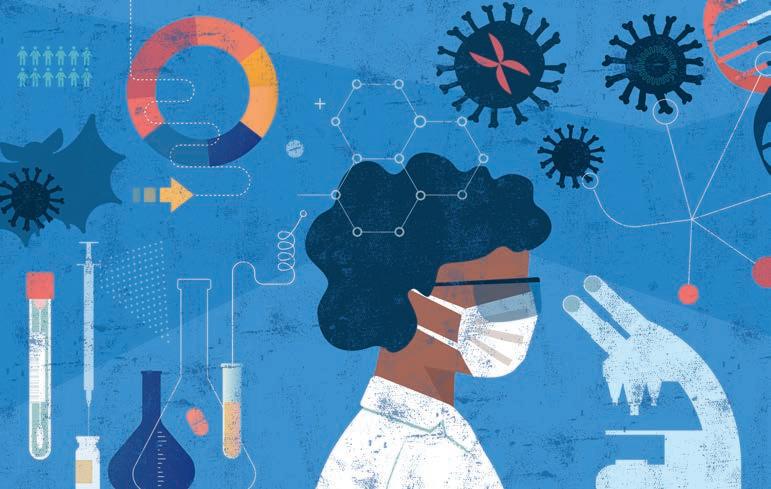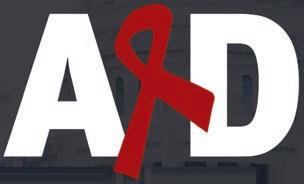












Using comedy as HIV medicine

This is only a brief summary of important information about BIKTARVY® and does not replace talking to your healthcare provider about your condition and your treatment.
BIKTARVY may cause serious side e ects, including:
` Worsening of hepatitis B (HBV) infection. Your healthcare provider will test you for HBV. If you have both HIV-1 and HBV, your HBV may suddenly get worse if you stop taking BIKTARVY. Do not stop taking BIKTARVY without fi rst talking to your healthcare provider, as they will need to check your health regularly for several months, and may give you HBV medicine.
BIKTARVY is a complete, 1-pill, once-a-day prescription medicine used to treat HIV-1 in adults and children who weigh at least 55 pounds. It can either be used in people who have never taken HIV-1 medicines before, or people who are replacing their current HIV-1 medicines and whose healthcare provider determines they meet certain requirements.
BIKTARVY does not cure HIV-1 or AIDS. HIV-1 is the virus that causes AIDS.
Do NOT take BIKTARVY if you also take a medicine that contains:
` dofetilide
` rifampin
` any other medicines to treat HIV-1
Tell your healthcare provider if you:
` Have or have had any kidney or liver problems, including hepatitis infection.
` Have any other health problems.
` Are pregnant or plan to become pregnant. Tell your healthcare provider if you become pregnant while taking BIKTARVY.
` Are breastfeeding (nursing) or plan to breastfeed. Talk to your healthcare provider about the risks of breastfeeding during treatment with BIKTARVY. Tell your healthcare provider about all the medicines you take:
` Keep a list that includes all prescription and over-thecounter medicines, antacids, laxatives, vitamins, and herbal supplements, and show it to your healthcare provider and pharmacist.
` BIKTARVY and other medicines may a ect each other. Ask your healthcare provider and pharmacist about medicines that interact with BIKTARVY, and ask if it is safe to take BIKTARVY with all your other medicines.
BIKTARVY may cause serious side e ects, including:
` Those in the “Most Important Information About BIKTARVY” section.
` Changes in your immune system. Your immune system may get stronger and begin to fight infections that may have been hidden in your body. Tell your healthcare provider if you have any new symptoms after you start taking BIKTARVY.
` Kidney problems, including kidney failure. Your healthcare provider should do blood and urine tests to check your kidneys. If you develop new or worse kidney problems, they may tell you to stop taking BIKTARVY.
` Too much lactic acid in your blood (lactic acidosis), which is a serious but rare medical emergency that can lead to death. Tell your healthcare provider right away if you get these symptoms: weakness or being more tired than usual, unusual muscle pain, being short of breath or fast breathing, stomach pain with nausea and vomiting, cold or blue hands and feet, feel dizzy or lightheaded, or a fast or abnormal heartbeat.
` Severe liver problems , which in rare cases can lead to death. Tell your healthcare provider right away if you get these symptoms: skin or the white part of your eyes turns yellow, dark “tea-colored” urine, light-colored stools, loss of appetite for several days or longer, nausea, or stomach-area pain.
` The most common side e ects of BIKTARVY in clinical studies were diarrhea (6%), nausea (6%), and headache (5%).
These are not all the possible side e ects of BIKTARVY. Tell your healthcare provider right away if you have any new symptoms while taking BIKTARVY.
You are encouraged to report negative side e ects of prescription drugs to the FDA. Visit www.FDA.gov/medwatch or call 1-800-FDA-1088.
Your healthcare provider will need to do tests to monitor your health before and during treatment with BIKTARVY.
Take BIKTARVY 1 time each day with or without food.
` This is only a brief summary of important information about BIKTARVY. Talk to your healthcare provider or pharmacist to learn more.
` Go to BIKTARVY.com or call 1-800-GILEAD-5.
` If you need help paying for your medicine, visit BIKTARVY.com for program information.






















































HIV affects the Black community disproportionately. If you’re living with the virus or seeking to prevent HIV, go to realhealthmag.com/tag/hiv for all the latest updates.
Health Basics A–Z
Want to lose weight, exercise smart, eat right, find good health care, sleep better or just get healthy?
For tips, click on “Health Basics A–Z” on the realhealthmag.com home page.
Eat

Find healthier recipes for your favorite foods. Go to realhealthmag.com/ tag/recipe for delicious alternatives.
Read Real Health magazine online exactly as it appears in print. Go to realhealthmag.com/digital to view the entire Smart + Strong digital library.


Two HIV service providers close; enduring impact of Black hospitals; new attack on Affordable Care Act; Ryan White funding
HIV study protocols; daily doxyPrEP; “Manhattan Project on HIV”; anal cancer screening guidelines
8
9
Citrus quinoa avocado salad
HIV advocate Andy Feds was born with the virus. Learn how he uses comedy as HIV medicine.
At realhealthmag.com, you can read more articles and access exclusive, online-only special reports. Plus, sign up for the Real Health email newsletter to get the latest news on issues relating to Black health!
Published by Smart + Strong, publishers of Real Health and RealHealthMag.com.
Copyright © 2024 CDM Publishing, LLC. All rights reserved. No part of this publication may be reproduced, stored or transmitted, in any form by any means, electronic, mechanical, photocopying, recording or otherwise, without the written permission of the publisher. Smart + Strong® and Real Health® are registered trademarks of CDM Publishing, LLC.
Send feedback to website@realhealthmag.com or Real Health Focus
c/o Smart + Strong, 157 Columbus Avenue, Suite 525, New York, NY 10023. Tel: 212-242-2163.
EDITORIAL
Managing Editor: Jennifer Morton
Deputy Editor: Trent Straube
Science Editor: Liz Highleyman
Copy Chief: Joe Mejía
Art Director: Mark Robinson
Production Manager: Michael Halliday
SMART + STRONG
President: Ian E. Anderson
Editorial Director: Oriol R. Gutierrez Jr.
Vice President, Integrated Sales: Diane Anderson
Integrated Advertising Manager: Jonathan Gaskell
Real Health Focus is an educational series on specific health topics.
The editorial content is independently produced by Smart + Strong.
Grants will assist Black populations at risk for HIV.
THE FEDERAL GOVERNMENT IS, FOR THE FIRST TIME, FUNDING A PILOT program that will provide generic pre-exposure prophylaxis (PrEP) medications to prevent HIV. Specifically, the Centers for Disease Control and Prevention (CDC) has made about $7 million available for PrEP programs in jurisdictions already receiving funding for the Ending the HIV Epidemic in the United States initiative.
The initiative targets counties, cities and other jurisdictions that account for a disproportionate number of new HIV cases and are prime recipients of PrEP e orts. As the federal government explains in its funding description:
“Jurisdictions with greater need for PrEP and lower uptake among priority populations disproportionately a ected by HIV and low PrEP prescriptions (i.e., Black and Latino gay, bisexual, and other men who have sex with men… and Black cisgender and transgender women) need these additional resources and flexibility to accelerate PrEP uptake through patient navigation/case management services and improve access to and utilization of existing PrEP services not covered by other financial resources.”
In addition to supporting PrEP access and uptake, the CDC funding available to health departments will support e orts to increase awareness of and access to post-exposure prophylaxis (PEP), which refers to antiretroviral medications taken soon after a potential exposure to HIV in order to prevent infection, as well as doxycycline post-exposure prophylaxis (doxyPEP) to prevent the sexually transmitted infections chlamydia, syphilis and gonorrhea.
The CDC funding was announced August 1. The formal title of the funding opportunity is High-Impact HIV Prevention and Surveillance Programs for Health Departments: Accelerating Pre-Exposure Prophylaxis (PrEP) Uptake for Ending the HIV Epidemic in the United States.
For several years, PrEP advocates have pressured the government to fund a national PrEP program to make the prevention tool available to those who need it most. Advocates from PrEP in Black America and PrEP4All, among others, praise this new funding opportunity.
—Trent Straube
The pilot program is available at seven Georgia locations.
To combat HIV transmission and improve access to care in Georgia, telemedicine provider MISTR has partnered with Walmart to o er free at-home HIV testing kits in seven Walmart stores, according to a MISTR news release.
In 2022, the South accounted for 49% of new HIV cases in the United States, according to the Centers for Disease Control and Prevention.
Georgia has some of the highest HIV rates in the nation. By the end of 2022, an estimated 63,984 people were living with HIV in Georgia, with 2,575 new diagnoses. In 2021, the Atlanta metro area had the third highest rate of new HIV diagnoses in the country, with more than 25 of every 100,000 people living with HIV.
“There is an undeniable HIV crisis in Georgia with very few resources available,” said MISTR CEO and founder Tristan Schukraft in the news release.
“This program not only marks MISTR’s first retail partnership but also addresses the community’s need for care options and increased sexual health education. I am proud that MISTR continues to democratize access to PrEP [pre-exposure prophylaxis], doxyPEP [doxycycline post-exposure prophylaxis] and longterm-HIV care and show up for these underserved individuals.”
Initial store locations include Atlanta, Ellenwood, Morrow, Decatur and Stockbridge.
Customers can take HIV testing kits home and get connected to care if necessary. MISTR also o ers related HIV care services such as testing for sexually transmitted infections, PrEP, doxyPEP and long-term HIV care.
Approximately 13% of people living with HIV in the United States don’t know they have the virus. Knowing your status is essential to protecting your health—and that of your partner.
MISTR has served over 350,000 people throughout the United States, including Puerto Rico.
To expand its reach, Schukraft, who founded MISTR to help friends access PrEP, said he plans to open storefronts across the United States in the coming years.
—Laura Schmidt
Clients of the Minnesota groups were left scrambling.
health care service provider for the HIV and LGBTQ communities, shuttered without warning July 19 due to financial problems, reports MinnPost. The loss comes just a few months after the African American AIDS Task Force (AAATF), which served Black Minnesotans, also closed.
Like most HIV service organizations, Rainbow Health and AAATF provided more than HIV testing, treatment and care. They provided food support, housing assistance, financial aid for living expenses, sobriety and mental health care, support groups and even legal support to transgender people who wanted to change their name, to mention just a few of the services they o ered.
The closures left people scrambling for assistance. For example, some clients at Rainbow Health faced having their utilities disconnected or even being evicted, according to MinnPost.
Several local organizations are stepping forward to address the crises, including the Aliveness Project, PFund and Interna Mental Health & Wellness. The Aliveness Project, MinnPost reports, is taking over contracts that were held by Rainbow Health, including
those funded by the federal Ryan White HIV/AIDS Program and by the Minnesota Department of Human Services. What’s more, the Aliveness Project has been able to provide financial assistance to many of Rainbow Health’s former clients.
“All of us opened extra spots on our schedule to take clients that lost services immediately,” Kaylee Bond, MA, LPCC, a cofounder and therapist at Interna, told the newspaper, adding that Interna is “working with Family Tree [Clinic] to cross-refer people who need gendera rming care or upcoming surgery requests for their gender-a rming care.”
The situation may become even more complicated in the future, as the Minnesota Department of Human Services plans to cut its HIV budget by $9 million, or 30%, next year, reports Sahan Journal.
Matt Toburen, the executive director of the Aliveness Project, said the budget cuts are the result of decreases in federal funding. He and other advocates are urging state lawmakers to provide more funding for HIV services and related programs. —Trent Straube
They were a major source of pride for Black Americans.
In the center of Mound Bayou, the historically Black Mississippi city once deemed “the jewel of the Delta” by President Theodore Roosevelt, dreams of revitalizing an abandoned hospital building have all but dried up.
An art deco sign still marks the main
entrance, but the front doors are locked, and the parking lot is empty. These days, a convenience store across North Edwards Avenue is far busier than the old Taborian Hospital, which first shut down more than 40 years ago.

Myrna Smith-Thompson, who serves as executive director of the civic group that owns the property, lives 100 miles away in Memphis and doesn’t know what’s to become of the deteriorating building.
A similar scenario has played out in hundreds of other rural communities across the United States, where hospitals have faced closure over the past 40 years. In that regard, the story of Mound Bayou’s hospital isn’t unique.
But there’s more to this hospital closure than the loss of inpatient beds, historians say. It’s also a tale of how hundreds of Black hospitals across the United

States were casualties to social progress.
The Civil Rights Act of 1964 and the enactment of Medicare and Medicaid in 1965 benefited millions of people. The federal campaign to desegregate hospitals, culminating in a 1969 court case out of Charleston, South Carolina, guaranteed Black patients across the South access to the same health care facilities as white patients.
No longer were Black doctors and nurses prohibited from training or practicing medicine in white hospitals. But the end of legal racial segregation precipitated the demise of many Black hospitals, which were a major source of employment and a center of pride for Black Americans.
“And not just for physicians,” said Vanessa Northington Gamble, a medical doctor and historian at George Washington University. “They were social institutions, financial institutions and also medical institutions.”
—Lauren Sausser and KFF Health News
Enhanced subsidies are set to expire in late 2025.
The A ordable Care Act (ACA) is back under attack. Not as in the repeal-andreplace debates of yore, but in a fresher take from Republican lawmakers who say key parts of the ACA cost taxpayers too much and provide incentive for fraud.
Several House Republican leaders have called on two watchdog agencies to investigate, while Senator Chuck Grassley (R–Iowa) fired o more than half a dozen questions in a recent letter to the Centers for Medicare & Medicaid Services.
At issue are the ACA’s enhanced subsidies, put in place during the COVID-19 pandemic as part of economic recovery legislation. Grassley said in a recent news release that the subsidies “left Obamacare, a program already riddled with problems, wide open to new
$1.4 Billion in
waste, fraud and abuse.”
While potential fraud in government programs has always been a rallying cry for conservatives, the recent criticisms are a renewed line of attack on the ACA because repealing it is unlikely, given that more than 21 million people enrolled in marketplace plans for this year.
“I see what’s happening right now as laying the groundwork for the big fight next year,” said Debbie Curtis, a vice president at consulting firm McDermott.
The enhanced subsidies are set to expire in late 2025. Without them, millions of Americans would likely see their premiums go up.
But the debate will also likely draw in other issues, including Trump-era tax cuts, which also must be addressed


next year. Also potentially in play are other aspects of the ACA, including a special year-round enrollment period and zero-premium plans for low-income consumers.

Much of what eventually happens will depend on the makeup of the Senate and House, as well as control of the White House, after the November elections. Both sides have incentive to extend all or part of the tax cuts, but each will want some kind of compromise on other issues as well.
—Lauren Sausser and KFF Health News
The awards benefit the AIDS Drug Assistance Program.
SERVICES Administration (HRSA) of the Department of Health and Human Services (HHS), in August announced more than $1.4 billion in Ryan White HIV/AIDS Program funding for the HRSA AIDS Drug Assistance Program (ADAP) and related awards. This HRSA funding ensures that individuals with HIV who have low incomes receive lifesaving medication, quality HIV health care and essential support services. This announcement supports and advances the Biden-Harris administration’s National HIV/AIDS Strategy.
HRSA-supported AIDS Drug Assistance Programs pay for HIV medication, co-pays and co-insurance for HIV medication and premiums for health insurance that covers HIV medication. This critical support helps individuals with HIV receive antiretroviral therapies, which help people reach viral suppression, meaning they cannot sexually transmit HIV and can live longer and healthier lives.
Without access to lifesaving HIV medication provided by HRSA-supported AIDS Drug Assistance Programs, HIV medication could cost an individual more than $40,000 per year, putting it otherwise out of reach. HRSA supports critical HIV care and medication in all 50 states, the District of Columbia, Puerto Rico, the U.S. Virgin Islands and six U.S. Pacific territories.
HHS Deputy Secretary Andrea Palm
announced the awards during the opening plenary session of HRSA’s 2024 National Ryan White Conference on HIV Care & Treatment in Washington, DC.
“The Ryan White HIV/AIDS Program is the cornerstone of this nation’s response to the HIV epidemic. Over half of people with diagnosed HIV in the United States—more than half a million people—receive services through the program each year,”
said Palm. “This funding makes it possible for people with HIV to access lifesaving medication and treatment that are proven to improve health outcomes, reduce HIV transmission and save lives. We are incredibly proud of the department’s leadership of the federal e ort to end the HIV epidemic in the United States and advance the Biden-Harris administration’s National HIV/AIDS Strategy.” —HHS



Research sites have enrolled about 93,000 participants.
THE NATIONAL INSTITUTE OF Allergy and Infectious Diseases (NIAID) supports four research networks as part of its HIV clinical research enterprise. The networks are made up of more than 100 clinical research sites, each with local experts, robust research infrastructure and well - trained cross -functional sta who maintain standardized procedures and quality controls aligned with their network.
The HIV clinical trials network sites have made tremendous contributions to
It’s another option for people who have sex often.
Doxycycline post-exposure prophylaxis (doxyPEP) for prevention of sexually transmitted infections (STIs) has been big news at recent AIDS conferences, but for people who have sex often, daily doxycycline pre-exposure prophylaxis (doxyPrEP) may also be an
the National Institute of Health’s scientific priorities by o ering direct access to and consultation with populations most a ected by HIV globally and by delivering high- quality clinical research with strong connections to trusted community outreach platforms. Their approach to community engagement anchors clinical research sites beyond the scope of any individual study and, when possible, aligns scientific questions and study protocols based on local context.
Since the start of the 2020 research
option. DoxyPEP is a single 200 milligram dose of the antibiotic taken within 72 hours after sex. DoxyPrEP, in contrast, involves taking half that dose every day.
In a study of 52 HIV-positive gay and bisexual men in Toronto and Vancouver, daily doxycycline reduced the incidence of chlamydia by 92%, syphilis by 79% and gonorrhea by 68% compared with a placebo.
Another study of 40 women sex workers seen at a clinic in Tokyo
network grant cycle, HIV clinical research sites have enrolled about 93,000 participants across 78 clinical trials in 25 countries. The networks were able to quickly pivot to support NIAID’s emerging infectious disease priority areas, including COVID -19 and mpox. Of the 93,000 participants since 2020, about 78,000 were enrolled into COVID -19 clinical trials sponsored by NIAID’s Division of AIDS.
Clinical trial sites currently operate with a hub - and - spoke model, with each hub providing centralized support to their linked clinical research sites. This model leverages shared resources where possible and practical and ensures robust oversight to promote high - quality clinical trial operations. Hubs provide infrastructure and services, including laboratory, pharmacy, regulatory, data management and training to support execution of NIAID - sponsored clinical research.
Future networks will need to maintain core strengths of current models while expanding capacity in areas vital to further scientific progress. These include operations that inform pandemic responses and extending our reach within communities impacted by HIV, including populations historically underrepresented in clinical research. Additionally, there may be opportunities for clinical research sites and other partners to conduct implementation science research based on their capacity and access to relevant populations in the context of specific scientific questions. — NIAID
found that those who used doxycycline every day saw a 67% decline in overall STI incidence. In both studies, daily doxycycline was safe and generally well tolerated.
“We need to provide patients with choice,” says Troy Grennan, MD, of the British Columbia Centre for Disease Control. “One of the assumptions we often make is that we know what patients will prefer, but we just don’t know.”
—Liz Highleyman
Clinical trials of a therapeutic vaccine are slated for 2025.
As the founder and sole owner of software company InterSystems, Phillip “Terry” Ragon is worth about $3.1 billion, according to Forbes. Now, he is applying his successful long-term approach to business toward a new challenge: curing HIV.
Ragon and his wife, Susan, have donated about $400 million to HIV cure research. What makes the billionaire businessman think his Ragon Institute in Cambridge, Massachusetts, will see more success than HIV researchers across the globe have experienced during the past four decades? To date, no HIV vaccine has made it beyond Phase III trials, and a cure has been elusive.
Ragon is funding riskier, earlierstage research, he tells Forbes, instead of putting the money in projects deemed not only important but also more likely to succeed.
“We started to evolve this whole idea
of a Manhattan Project on HIV,” Ragon said, referencing the program responsible for the development of the first atomic bomb during World War II. “If you tried to do the Manhattan Project back during World War I, you would have failed because we didn’t know about quantum mechanics. If you waited until World War III, you’d have been too late.”
The HIV cure research team at the Ragon Institute is inspired by “elite controllers,” folks who are living with HIV but show no symptoms of illness despite not taking HIV meds; in fact, they control the virus naturally and don’t have a detectable viral load.
Bruce Walker, the founding director of the Ragon Institute, says researchers are trying to replicate the powerful immune systems of elite controllers. “If we could achieve that state in people who are infected,” Walker tells Forbes, the results could
lead to a “functional cure.”
For this HIV cure project, Ragon scientists have teamed up with researchers at the Gates Foundation, the International AIDS Vaccine Initiative and the Italian drug developer ReiThera, according to Forbes. Next year, they plan to start Phase I clinical trials of a T-cell–based vaccine that they hope will replicate the immune system of elite controllers. —Trent Straube
Recommendations for people living with HIV now include anal cancer prevention.
For the first time, government guidelines for the management of opportunistic infections now include recommendations on anal cancer prevention for people living with HIV, who are at higher risk than the general population. Anal cancer is caused by the human papillomavirus (HPV), which triggers abnormal cell growth that can progress to invasive cancer.
According to the new guidelines, men who have sex with men and transgender women should start anal cancer screening at age 35, while other HIV-positive people should start at age 45. This should include symptom assessment and a digital anal-rectal exam; those with abnormalities should receive follow-up evaluation. The screening algorithm includes recommendations for anal cytology (Pap tests) and testing for high-risk HPV types if high-resolution anoscopy (HRA)—a technique that uses a magnifying scope to examine the anal canal—is available.
The new recommendation is supported by evidence from the ANCHOR study, which showed that screening HIV-positive
men and women ages 35 and older for precancerous lesions and treating them promptly lowered the risk of progression to anal cancer by more than half. A recent study that compared anal screening strategies for people with HIV found that combining cytology and high-risk HPV testing was more e ective than either method alone and reduced the need for follow-up HRA evaluation, which is limited due to a shortage of trained providers.
A recent analysis estimated that over 400,000 HIV-positive people may have abnormal anal cytology, but more than a third have no access to follow-up HRA.
“We need better screening strategies to identify people who are at the highest risk,” says Michael Gaisa, MD, PhD, of the Icahn School of Medicine at Mount Sinai. While screening and prompt treatment can prevent progression to anal cancer, HPV vaccination can prevent infection in the first place. The CDC recommends the Gardasil 9 vaccine for girls and boys at ages 11 or 12, with catch-up vaccination through age 26, but the Food and Drug Administration has approved it for people up to age 45. Yet men who have sex with men are missing out on vaccination. A recent study found that more than half of HIV-positive and HIV-negative gay men in San Francisco had not received an HPV vaccine, often because they were too old. The researchers suggest that guidelines should be changed to recommend HPV vaccination for gay and bisexual men of all ages.
Maintaining viral suppression is one of the best ways to preserve kidney function.
HEALTHY KIDNEYS ARE KEY TO a good quality of life. Kidney function diminishes as we age, but you can take steps to keep these organs in good working order.
The kidneys filter the blood, sending waste products and excess water to the bladder to be excreted in urine. Kidney tubules reabsorb fluid, minerals and nutrients and return them to the bloodstream. The kidneys also regulate blood pressure and maintain blood chemistry.
Acute kidney failure can occur suddenly—for example, due to toxins or physical injury. Chronic kidney disease (CKD), in contrast, leads to a slow decline in function over time. Kidney disease symptoms may include frequent urination, fatigue, brain fog, muscle cramps and swelling, but early stages are often asymptomatic.
Older age is the biggest risk factor for CKD. Others include male sex, Black race, family history, diabetes, hepatitis C and use of certain medications. High
blood pressure (hypertension) is both a leading cause of kidney damage and a sign of kidney impairment.
Studies have found that up to one third of people living with HIV have abnormal kidney function, but some of these were done before the era of e ective antiretroviral treatment. HIV can directly harm the kidneys (known as HIV-associated nephropathy, or HIVAN) and cause damaging inflammation.
Certain HIV medications can themselves cause kidney problems. Among widely used modern antiretrovirals, this occurs most often with tenofovir disoproxil fumarate, or TDF (a component of Truvada). A newer version, tenofovir alafenamide, or TAF (a component of Descovy), is easier on the kidneys and bones. Kidney problems are uncommon among HIV-negative people taking Truvada for pre-exposure prophylaxis (PrEP). Some older antiretrovirals and drugs used to treat opportunistic illnesses
caused more severe kidney toxicity, and long-term survivors may have lingering kidney problems.
Kidney function is assessed in various ways. The presence of protein or blood in the urine is one early sign of kidney damage. The estimated glomerular filtration rate (eGFR) is calculated using blood creatinine levels, age, sex and body size. A normal eGFR for a healthy adult is 90 to 120 milliliters per minute. An eGFR between 60 and 90 indicates early CKD, but the kidneys still mostly function well at that stage. People with moderate kidney disease (eGFR 30 to 59) may start to experience symptoms. An eGFR below 15 indicates end-stage renal disease, or kidney failure.
HIV treatment guidelines recommend that kidney function should be assessed at the time of HIV diagnosis, measured before starting a new HIV treatment or PrEP regimen and monitored regularly thereafter. People with impaired kidney function and those at high risk should avoid medications linked to kidney toxicity or use them with caution. Fortunately, drug-related kidney problems often resolve if they are caught early and the o ending medication is stopped.
Kidney disease treatment focuses on managing comorbidities to slow disease progression. Various types of drugs are used to control high blood pressure and diabetes. A balanced diet, good hydration, exercise, weight loss, smoking cessation and limited alcohol consumption all contribute to kidney health. Starting antiretroviral treatment promptly and maintaining an undetectable viral load is one of the best ways to preserve kidney function.
Once people progress to end-stage renal disease, kidney damage is likely to be irreversible, and they may need hemodialysis (using a machine to filter the blood) or a kidney transplant. Diagnosing and managing kidney problems early are therefore key to preventing life-threatening kidney failure. — Liz Highleyman

This plant-based dish is a satisfying meal for everyone.
This colorful quinoa avocado salad with zesty lemons and fresh cilantro is full of vibrant flavors. It’s also rich in cancer-fighting foods, including avocados, which contain healthy monounsaturated fat, and fiber-rich quinoa, chickpeas and fresh vegetables. This plant-based meal is hearty and filling enough to satisfy everyone.
SERVINGS: 4 / INGREDIENTS: 17 / PREP: 20 minutes
For the salad:
½ cup cucumber, diced
1 cup cherry tomatoes, cut in half
2 small cloves garlic, minced
¼ cup red onion, chopped
1 bunch cilantro
1 (15.5 ounce) can chickpeas, no-salt-added or low-sodium (drained and rinsed)
2 cups spinach, thinly sliced
1 cup cooked and cooled quinoa
2 medium avocados, diced
DIRECTIONS
1. Place all salad ingredients in a bowl.
For the dressing:
Juice of 2 lemons
Zest of 1 lemon
2 teaspoons Dijon mustard
1 tablespoon olive oil
1 teaspoon honey
½ teaspoon ground cumin
Salt and pepper, to taste
Dash of cayenne pepper (optional)
2. Whisk together all dressing ingredients in a separate bowl.
3. Drizzle dressing over salad mixture and gently toss ingredients together until dressing is incorporated throughout.
CHEF TIP
This recipe contains cancer-fighting foods: whole grains.
NUTRITION FACTS (per serving)
Calories: 544; fat: 24 g; saturated fat: 3 g; polyunsaturated fat: 5 g; monounsaturated fat: 14 g; carbohydrates: 72 g; sugar: 10 g; fiber: 20 g; protein: 18 g; sodium: 927 mg

©2024 Fred Hutchinson Cancer Research Center, a 501(c)(3) nonprofit organization. Used with permission.
These foods are a great way to boost your health.
By Craig Ramsay
Imagine if you could lower your cholesterol, reduce the risk of heart disease and cancer and improve your state of mind with food? Turns out, you can! Superfoods contain a high level of certain nutrients and are a great way to boost your health. Put these fruits in your grocery cart:
Q Apples
Q Avocados
Q Bell peppers
Q Blueberries
Q Cherries
Q Goji berries
Q Lemons
Q Limes
Q Pineapples
Q Pumpkins
Q Tomatoes
Q Winter squashes


Craig Ramsay is a fitness expert, an author and the winner of season 8 of The Amazing Race Canada. Follow him on Instagram at @craigramsayfit


By Alicia Green
When stand-up comedian Andy Feds hits the stage wearing one of his many fedoras, his audience is usually surprised by what comes next. The 31-year-old Las Vegas resident kicks o his set by sharing something very personal. He announces that he was born with HIV.
“That’s the first thing I open up with because it teaches people that you can be born HIV positive,” says Feds, whose stage name is a nod to both a high school teacher and his love of fedoras. “If I’m open about it and free, you’re going to laugh at these jokes.”
It was a decision Feds says he made at age 24 after he received word from God directing him to disclose his status. Prior to that, he hadn’t shared his HIV status publicly.
“I immediately went to Facebook,” Feds says. “I made a post about how I was going to switch up my stand-up comedy to focus solely on my HIV status, break stigmas and teach people about the factual information.”
At the time, Feds had been performing comedy for about five years. But the transition to a routine focused on HIV wasn’t easy.
“A lot of people did not want to hear comedy and HIV in the same sentence,” he says. “I had to rework and retool to figure out how to make this funny but also distracting to the point where people get out of that mindset of ‘I can’t laugh at this.’”
“With me doing stand-up comedy, I figured that’s an untapped market when it comes to HIV awareness,” Feds says.
They say laughter is the best medicine, and comedy certainly has been healing for Feds. It’s helped him navigate his own journey living with HIV. Indeed, stand-up is like therapy for him.
“I’m talking to strangers about my problems,” he says. “Except, this time, I’m actually laughing at it. It felt more healing than going to therapy to talk about my HIV.”
Although Feds was born with HIV, he wasn’t diagnosed until later. His mother, Lynette Cox, had contracted the virus from an ex-boyfriend and only learned her status when someone from the health department knocked on her door one day.
“When she got diagnosed, she didn’t want to live with the fact that she was living with this virus that was taking a lot of people out,” Feds says. “So she didn’t take her medicine out of fear, and that eventually led to me being diagnosed [at age 3].”
Her denial also a ected Feds because she didn’t give him his meds either.
“I can’t hold resentment,” Feds says. “Now, was it the best idea for her to just not take her medicine and not give me mine? Absolutely not! But I cannot fault her for being scared. AIDS was killing a lot of people, like COVID-19 in 2020, and she thought she was next.”
His mom died of AIDS-related complications at age 26 in 1998. Her death was tough for 5-year-old Feds, who didn’t
“It was like, Are they going to label me these misconceptions that they heard from people that have no idea what they’re talking about?” he says. “As I got older, that’s when I was really like, All right, I got to be that voice for people saying what you learned is absolutely false and here’s the actual facts.”
Feds didn’t start dating until college. He gained a lot of self-confidence and self-awareness during that time. This was in large part due to the birth of the Undetectable Equals Untransmittable (U=U) movement. U=U means that a person with HIV who achieves and maintains an undetectable viral load cannot transmit the virus to others through sex. This fact is also known as treatment as prevention.
Feds is currently undetectable. He adheres to a two-pill daily regimen—a far cry from the 10 pills he used to take every day.
College is also where Feds started taking comedy seriously. In high school, he’d been the class clown. But in college, he met an even bigger jokester, and that changed everything. The two men would constantly try to one-up each other to amuse their classmates. Eventually, they formed a stand-up comedy club at school.
“WE’VE GOT TO DO OUR
understand what was happening. He started asking questions.
“It was explained to me about HIV and AIDS,” he says. “But it was just the very basics that you teach a 5-year-old. As I got older, that’s when it started to become a little bit more of a mature conversation.”
Feds’s grandmother started raising him after his mother’s death. He began to ask questions about why he was always taking medicine. Eventually, his grandmother asked his doctors and nurses to better explain things to him.
“That’s when I really started to grasp the concept of ‘Hey, you’re living with this virus that other people are not living with, and that’s why you’re a little bit di erent.’”
Feds grew up in Chicago, where only close family and friends knew about his status. His grandmother never disclosed on his school records that he was HIV positive. She feared that people would bully him if they knew.
“I always heard the HIV jokes,” Feds says. “Somebody talking about ‘Oh, you got HIV’ or ‘Oh, you got AIDS.’ I heard people say HIV is just for gay people. It did hurt. I think that’s why I didn’t date as a teenager.”
Feds struggled with stigma. He feared girls would reject him if they knew his status.
“I remember I made a joke [at the first show],” Feds says. “I had a classmate running around the entire theater just cracking up laughing. Immediately, I was like, I think this is what I really want to do.”
Feds first tackled HIV and AIDS stigma through comedy in college. Someone who knew his status had asked whether he’d be willing to perform in front of their HIV and AIDS class. At the time, Feds didn’t share his status with too many people.
“The teacher told me, ‘Hey, you got 15 minutes,’” he recalls. “I’m in the hallway literally writing jokes. I don’t know how they came to me.”
As they say in comedy, he killed. It was far from his usual routine, but it would eventually lead him down a new path.
In 2017, Feds introduced himself at a show in Las Vegas as the first-ever HIV-positive stand-up comedian born with the virus. But it didn’t go like he thought it would.
“I remember people were looking at me like deer in headlights,” says Feds, who moved to Las Vegas about eight years ago. “Immediately, they tuned out because they heard HIV and comedy. When I got o the stage, I was like, All right, that didn’t get the reaction I wanted.”
He had expected the crowd to laugh like his classmates had. So he started taking part in comedy open mics to hone his craft.
“I started to work on those bits a little bit better and on the delivery,” he says. “People were loving it.”
Feds has come a long way since then. In 2022 and 2023, he kicked o his Keeping It Positive U.S. tour, performing at colleges, universities and nonprofit HIV organizations. He ended each set with a Q&A session.
“It would always be engaging because it does unlock people’s fear of talking about these things,” he says.
He wants people to ask him about sex, dating and anything else they’re curious about. The goal is to normalize conversations about people living with HIV having sex and being in relationships.
Feds is currently in a relationship. He met his girlfriend on a dating app. After chatting for a while, they exchanged numbers and started texting. They FaceTimed a few times before Feds shared his status with her.
“She said she was educated about it, and she didn’t see me as a virus,” he says. “She was like, ‘As long as you’re taking care of yourself, why should I stop getting to know you?’”
They’ve been together for over six months. His girlfriend has even been involved in his Keeping It Positive movement on social media. Feds often posts funny, engaging videos about living with HIV on various platforms. He is on TikTok and Instagram as @andyfedscomedy. He’s also on Facebook as Andy Feds.
In fact, Feds recently created a Facebook group called Blood Relatives (Red Ribbon Community). It’s a space for people living with HIV to get to know and encourage one another and grow together.
His videos address such topics as taking HIV medication, HIV and AIDS stigma and serodiscordant couples (where one person has HIV and the other doesn’t). He also uses his videos to encourage people to get tested for HIV. Although he has thousands of followers, Feds says he’s encountered his fair share of haters as well.
“People hate to see you confident about yourself and confident in what you do,” he says. “They see pictures of me and my girlfriend and say, ‘She must be desperate if she is with you. Why would she be with you if you’re HIV positive?’”
These comments don’t deter Feds from creating content. He continues to challenge the narrative that people living with HIV are unlovable. He also wants people to know that an HIV diagnosis is not a death sentence and that support and resources for people living with HIV abound.
“I always try to make sure people know that my inbox is open,” he says. “I’m not in it for the money or for the followers. I really just want to make sure that other people who are like my mother are not living the same way she did.”
Feds hopes that by sharing his story through comedy he can empower other people living with HIV. He also wants to normalize conversations around HIV for straight men living with HIV.
Because even today, many people equate having HIV with

Feds was born with HIV.
being gay. It’s a misconception he wants to change.
“People aren’t getting that education because we don’t want to talk about sexual health at all,” he says. “People will see me on TikTok talking openly about my HIV, and they’ll be like, ‘Why are you talking about this?’”
They will even see his girlfriend and still assume that he’s most likely gay.
“The concept of being straight with HIV is foreign to people for whatever reason, and I think the reason is because of stigma,” he says.
“We’ve got to do our part to normalize these things,” he says.
Feds plans to continue his Keeping It Positive tour because “when we communicate, we cure the mental stigmas that we battle by building self-confidence, self-love and self-respect,” he says.
He adds that he hopes normalizing conversations about HIV can one day help lower transmission rates to zero.
To join Feds on his comedy journey living with HIV, visit AndyFedsComedy.com. Q












